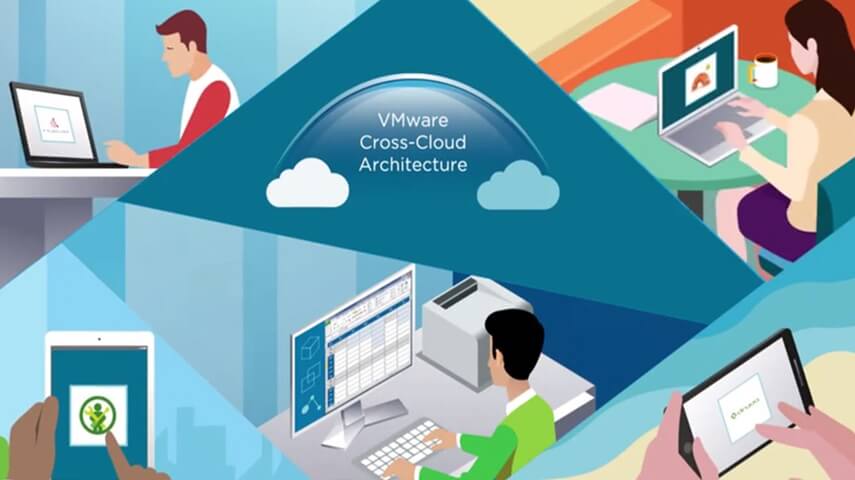You must have heard of VMware a lot. Actually what is VMware? VMware is a Cloud Computing and Virtualization Company founded in 1998. VMware has products for virtualizing hardware (Server, Storage, Network) This virtualization creates abstract layers on hardware that allows hardware such as processors, memory, storage space, etc. to be shared into multiple virtual computers which are commonly called virtual machines (VMs). Each of these virtual machines runs its own operating system and acts like a standalone computer, even though it is still a hardware part of the original computer.
As you can imagine, virtualization can make the use of computer hardware more efficient and can increase return on investment (ROI). This can also allow cloud computing service providers, both private clouds and public clouds, to serve more users with the computer hardware they already have.
Benefits offered
By using VMware products and services for cloud computing infrastructure, you will get many benefits. Please see the explanation below.
1. Efficient allocation of IT resources
VMware allows you to use more physical computer resources. Administrators don’t like running multiple applications on a single server because if one application crashes, it can make the OS unstable and crash the other applications currently running.
One way to reduce this risk is to run each application on its own OS and on its own virtual server. However, this would be very inefficient as each OS would be consuming 30% of the CPU. With VMware, you can run every application with its own OS on the same server, so you can make better use of CPU power.
2. Energy and Space Efficiency
VMware allows you to run multiple applications using fewer physical servers. Fewer physical servers obviously take up less space in your data center, making it more energy and space efficient.
3. Best Support
VMware is the leading and most popular virtualization service provider with more than 500,000 users. They also have a network of more than 75,000 customer support with a variety of additional services and products.
Virtualization on VMware
After knowing the explanation of the meaning and benefits, here are the various virtualization components from VMware and how they work.
1. VMware Hypervisor
VMware virtualizes physical computers using hypervisors. A hypervisor is a thin layer of software that interacts with the resources on a physical computer (Host), then allocates these resources to other operating systems (Guest). The Guest operating system requests these resources from the hypervisor.
The hypervisor divides each host operating system so that it can continue to operate without interference from others. If one of the Guest operating systems crashes, becomes unstable, or gets infected with malware, it will not affect the performance of the others.
2. VMware ESX
The VMware ESXi hypervisor data center focuses on type 1 or “bare metal” hypervisors, replacing the main operating system that may interact with the physical components of a computer. ESXi replaced ESX and has a bigger hypervisor so ESX is no longer in production.
- VMware vs Hyper-V: Microsoft has Hyper-V which is a hypervisor product that allows you to run multiple operating systems on the same server. Like ESXi, Hyper-V is a type 1 hypervisor that interacts with physical computing and memory resources. When enabled, Hyper-V will be installed along with the Windows operating system, so that Windows has direct access to the default hardware.
- VMware vs Citrix: Citrix offers both application and desktop virtualization, and has a long history in the desktop integration market. The primary hypervisor offered is the Citrix Hypervisor, known as XenServer, which competes with VMware vSphere. Citrix’s desktop and application virtualization products compete with VMware’s Horizon.
- VMware vs KVM: Both VMware’s ESXi and KVM are hypervisors, but KVM is part of the Linux kernel. KVM’s main advantage over ESXi is that it is an open source product, so the code base is transparent. Like most open source projects, it definitely requires extra work. You can also purchase Red Hat Virtualization as well.
Installing VMware Tools
There is one good thing about having a second operating system on your computer, namely the ability to replace data with the first operating system. That’s where VMware comes in. It is a crucial part of any VMware Workstation environment, and allows the Guest operating system to run in a type 2 hypervisor to work better with the Host operating system.
The advantage of installing VMware Tools will also make graphics performance faster and help share folders between the Guest and Host operating systems. You can use it to drag and drop, cut and paste between the two operating systems.
To install VMware Tools, click VM and then install VMware Tools from the VMware Workstation menu. VMware Workstation will mount a virtual CD-ROM on the Guest operating system containing the VMware Tools installer. You then access the CD-ROM and run the installer.
VMware’s Type 2 hypervisor competes with many other products on the market. You can see the comparison below.
- VMware vs Virtualbox: Virtualbox is a type 2 hypervisor manufactured by Innotek. Virtualbox is a free, open source product that allows you to install and use it on other operating systems even if you already have it on your laptop or computer. Each product has its own strengths and weaknesses in different areas. VMware products offer good 3D graphics, while Virtualbox can create more virtual disk images.
- VMware vs Parallels: Parallels is a type 2 hypervisor dedicated to running Guest operating systems on the macOS platform, and competes with VMMware Fusion. Parallels can be used with a single payment and with a subscription model.
Using VMware on public cloud or private cloud can be a solution for your business. Because in addition to elastic infrastructure for AI/ML applications through hardware accelerators such as GPUs, you can also deploy various data and memory intensive applications via real-time analysis.

